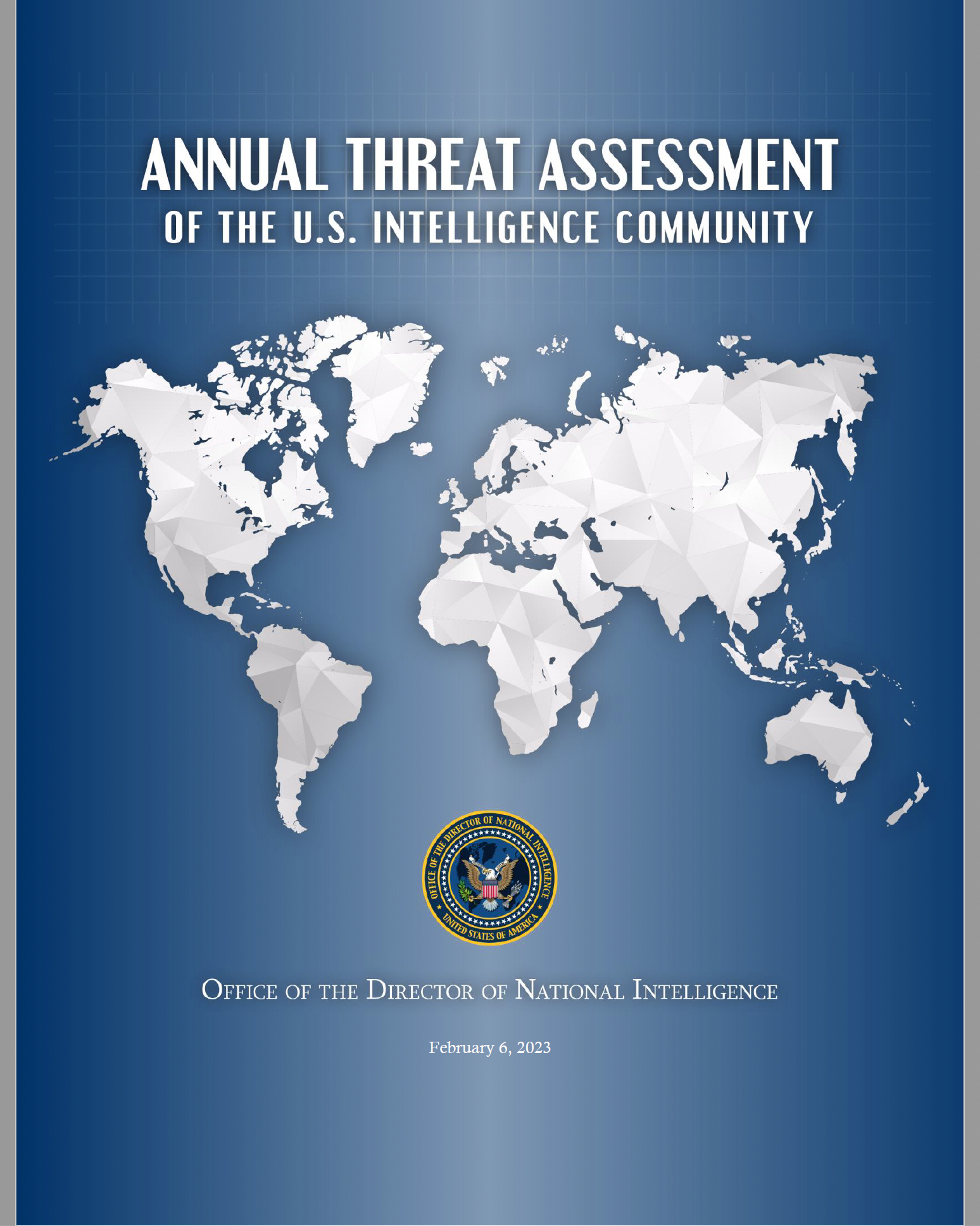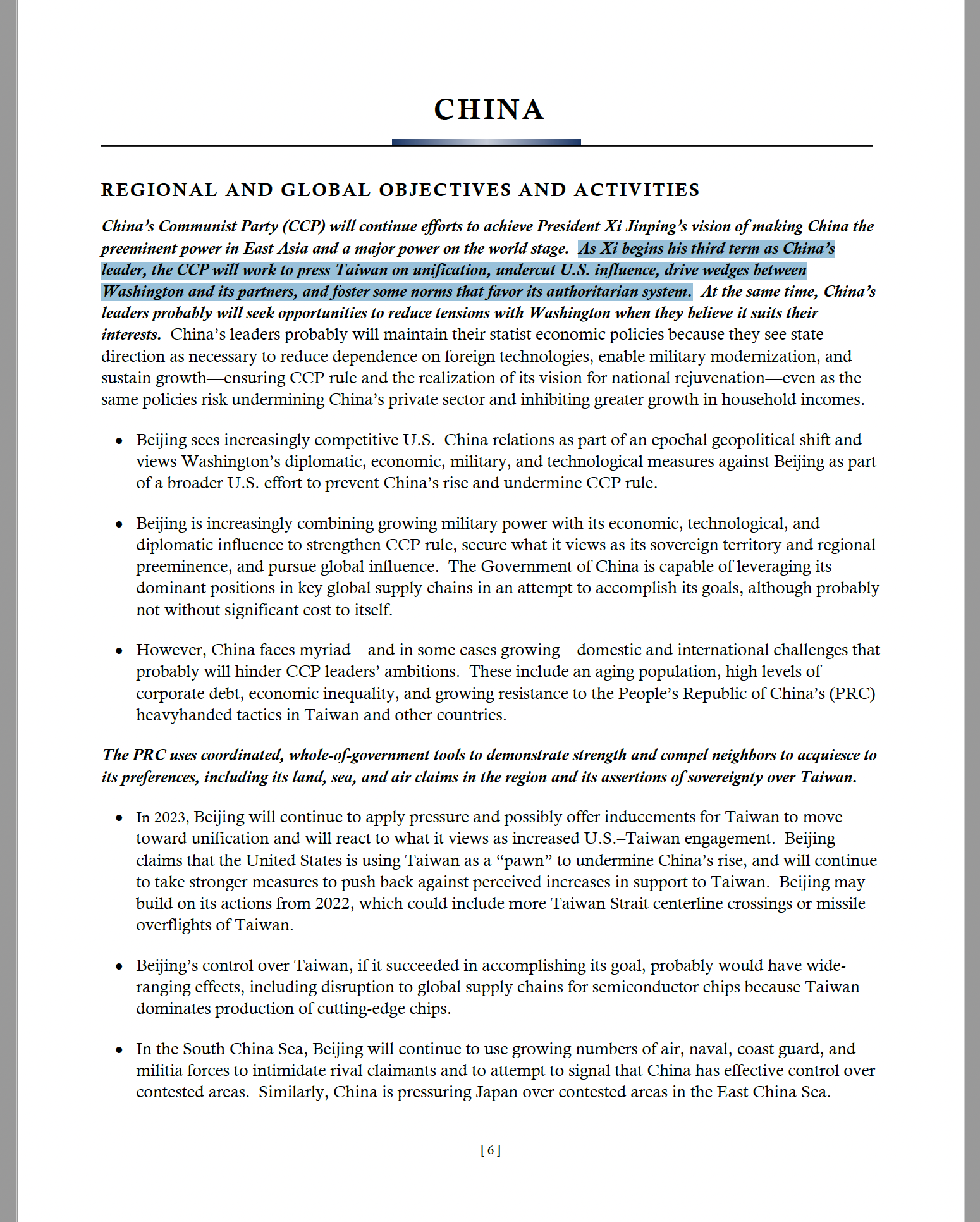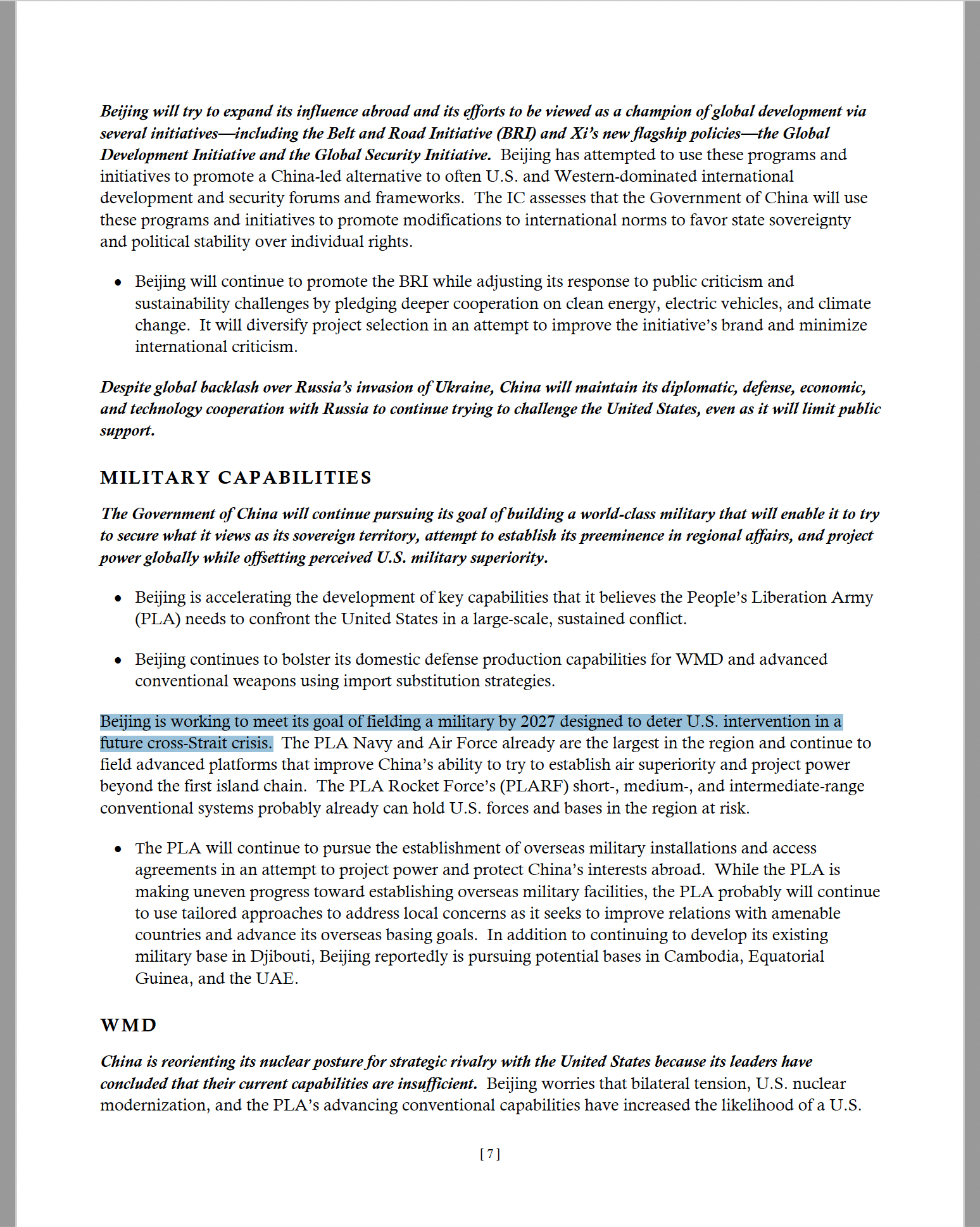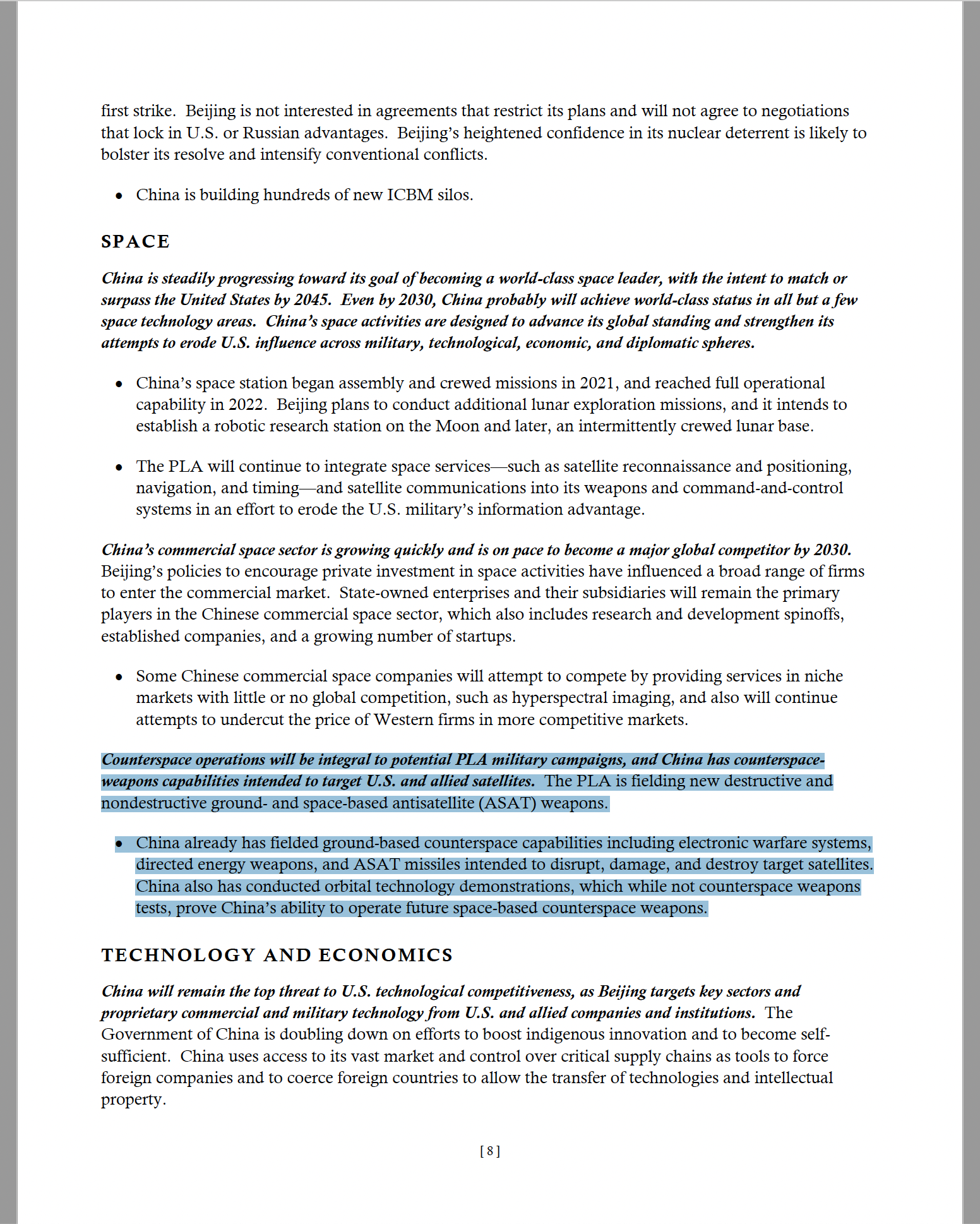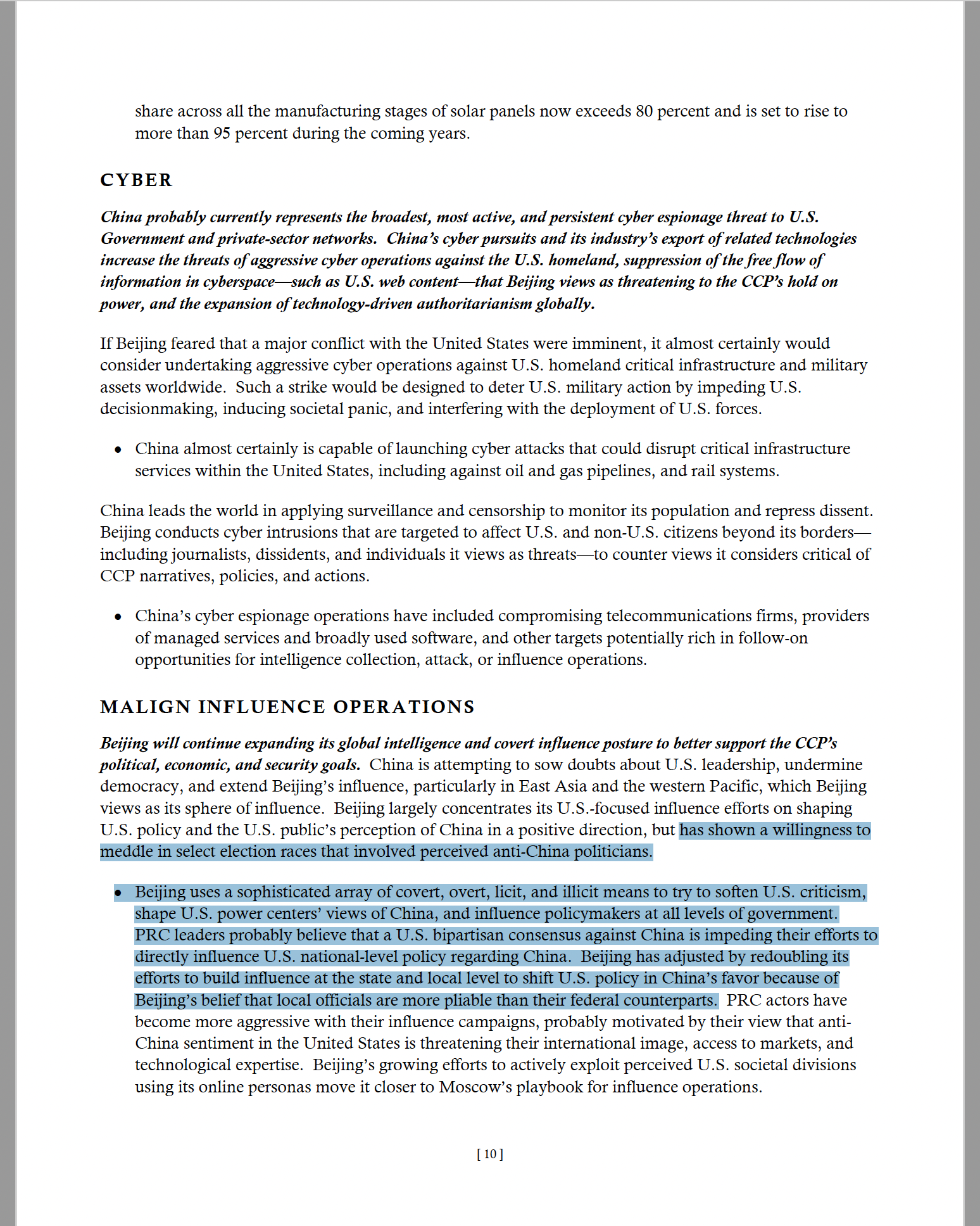ODNI’s “Annual Threat Assessment of the U.S. Intelligence Community”—Key China Content
Annual Threat Assessment of the U.S. Intelligence Community (McLean, VA: Office of the Director of National Intelligence, 6 February 2023).
This annual report of worldwide threats to the national security of the United States responds to Section 617 of the FY21 Intelligence Authorization Act (Pub. L. No. 116-260). This report reflects the collective insights of the Intelligence Community (IC), which is committed every day to providing the nuanced, independent, and unvarnished intelligence that policymakers, warfighters, and domestic law enforcement personnel need to protect American lives and America’s interests anywhere in the world.
This assessment focuses on the most direct, serious threats to the United States during the next year. The order of the topics presented in this assessment does not necessarily indicate their relative importance or the magnitude of the threats in the view of the IC. All require a robust intelligence response, including those where a near-term focus may help head off greater threats in the future.
Information available as of 18 January was used in the preparation of this assessment.
p. 4
During the coming year, the United States and its allies will confront a complex and pivotal international security environment dominated by two critical strategic challenges that intersect with each other and existing trends to intensify their national security implications. First, great powers, rising regional powers, as well as an evolving array of non-state actors, will vie for dominance in the global order, as well as compete to set the emerging conditions and the rules that will shape that order for decades to come. Strategic competition between the United States and its allies, China, and Russia over what kind of world will emerge makes the next few years critical to determining who and what will shape the narrative perhaps most immediately in the context of Russia’s actions in Ukraine, which threaten to escalate into a broader conflict between Russia and the West. … …
Russia’s unprovoked full-scale invasion of Ukraine has highlighted that the era of nation-state competition and conflict has not been relegated to the past but instead has emerged as a defining characteristic of the current era. While Russia is challenging the United States and some norms in the international order in its war of territorial aggression, China has the capability to directly attempt to alter the rules-based global order in every realm and across multiple regions, as a near-peer competitor that is increasingly pushing to change global norms and potentially threatening its neighbors. Russia’s military action against Ukraine demonstrates that it remains a revanchist power, intent on using whatever tools are needed to try to reestablish a perceived sphere of influence despite what its neighbors desire for themselves, and is willing to push back on Washington both locally and globally. Besides these strategic competitors, local and regional powers are seeking to exert their influence, often at the cost of neighbors and the world order itself. Iran will remain a regional menace with broader malign influence activities, and North Korea will expand its WMD capabilities while being a disruptive player on the regional and world stages.
At the same time, as the nations of the world strive to recover from the COVID-19 pandemic, they are beset by an array of shared, global issues. The accelerating effects of climate change are placing more of the world’s population, particularly in low- and middle-income countries, under threat from extreme weather, food insecurity, and humanitarian disasters, fueling migration flows and increasing the risks of future pandemics as pathogens exploit the changing environment. Efforts by Russia, China, and other countries to promote authoritarianism and spread disinformation is helping fuel a larger competition between
p. 5
democratic and authoritarian forms of government. This competition exploits global information flows to gain influence and impacts nearly all countries, contributing to democratic backsliding, threats of political instability, and violent societal conflict through misinformation and disinformation.
p. 6
CHINA
REGIONAL AND GLOBAL OBJECTIVES AND ACTIVITIES
China’s Communist Party (CCP) will continue efforts to achieve President Xi Jinping’s vision of making China the preeminent power in East Asia and a major power on the world stage. As Xi begins his third term as China’s leader, the CCP will work to press Taiwan on unification, undercut U.S. influence, drive wedges between Washington and its partners, and foster some norms that favor its authoritarian system. At the same time, China’s leaders probably will seek opportunities to reduce tensions with Washington when they believe it suits their interests. China’s leaders probably will maintain their statist economic policies because they see state direction as necessary to reduce dependence on foreign technologies, enable military modernization, and sustain growth—ensuring CCP rule and the realization of its vision for national rejuvenation—even as the same policies risk undermining China’s private sector and inhibiting greater growth in household incomes.
- Beijing sees increasingly competitive U.S.–China relations as part of an epochal geopolitical shift and views Washington’s diplomatic, economic, military, and technological measures against Beijing as part of a broader U.S. effort to prevent China’s rise and undermine CCP rule.
- Beijing is increasingly combining growing military power with its economic, technological, and diplomatic influence to strengthen CCP rule, secure what it views as its sovereign territory and regional preeminence, and pursue global influence. The Government of China is capable of leveraging its dominant positions in key global supply chains in an attempt to accomplish its goals, although probably not without significant cost to itself.
- However, China faces myriad—and in some cases growing—domestic and international challenges that probably will hinder CCP leaders’ ambitions. These include an aging population, high levels of corporate debt, economic inequality, and growing resistance to the People’s Republic of China’s (PRC) heavyhanded tactics in Taiwan and other countries.
The PRC uses coordinated, whole-of-government tools to demonstrate strength and compel neighbors to acquiesce to its preferences, including its land, sea, and air claims in the region and its assertions of sovereignty over Taiwan.
- In 2023, Beijing will continue to apply pressure and possibly offer inducements for Taiwan to move toward unification and will react to what it views as increased U.S.–Taiwan engagement. Beijing claims that the United States is using Taiwan as a “pawn” to undermine China’s rise, and will continue to take stronger measures to push back against perceived increases in support to Taiwan. Beijing may build on its actions from 2022, which could include more Taiwan Strait centerline crossings or missile overflights of Taiwan.
- Beijing’s control over Taiwan, if it succeeded in accomplishing its goal, probably would have wide-ranging effects, including disruption to global supply chains for semiconductor chips because Taiwan dominates production of cutting-edge chips.
- In the South China Sea, Beijing will continue to use growing numbers of air, naval, coast guard, and militia forces to intimidate rival claimants and to attempt to signal that China has effective control over contested areas. Similarly, China is pressuring Japan over contested areas in the East China Sea.
p. 7
Beijing will try to expand its influence abroad and its efforts to be viewed as a champion of global development via several initiatives––including the Belt and Road Initiative (BRI) and Xi’s new flagship policies—the Global Development Initiative and the Global Security Initiative. Beijing has attempted to use these programs and initiatives to promote a China-led alternative to often U.S. and Western-dominated international development and security forums and frameworks. The IC assesses that the Government of China will use these programs and initiatives to promote modifications to international norms to favor state sovereignty and political stability over individual rights.
- Beijing will continue to promote the BRI while adjusting its response to public criticism and sustainability challenges by pledging deeper cooperation on clean energy, electric vehicles, and climate change. It will diversify project selection in an attempt to improve the initiative’s brand and minimize international criticism.
Despite global backlash over Russia’s invasion of Ukraine, China will maintain its diplomatic, defense, economic, and technology cooperation with Russia to continue trying to challenge the United States, even as it will limit public support.
MILITARY CAPABILITIES
The Government of China will continue pursuing its goal of building a world-class military that will enable it to try to secure what it views as its sovereign territory, attempt to establish its preeminence in regional affairs, and project power globally while offsetting perceived U.S. military superiority.
- Beijing is accelerating the development of key capabilities that it believes the People’s Liberation Army (PLA) needs to confront the United States in a large-scale, sustained conflict.
- Beijing continues to bolster its domestic defense production capabilities for WMD and advanced conventional weapons using import substitution strategies.
Beijing is working to meet its goal of fielding a military by 2027 designed to deter U.S. intervention in a future cross-Strait crisis. The PLA Navy and Air Force already are the largest in the region and continue to field advanced platforms that improve China’s ability to try to establish air superiority and project power beyond the first island chain. The PLA Rocket Force’s (PLARF) short-, medium-, and intermediate-range conventional systems probably already can hold U.S. forces and bases in the region at risk.
- The PLA will continue to pursue the establishment of overseas military installations and access agreements in an attempt to project power and protect China’s interests abroad. While the PLA is making uneven progress toward establishing overseas military facilities, the PLA probably will continue to use tailored approaches to address local concerns as it seeks to improve relations with amenable countries and advance its overseas basing goals. In addition to continuing to develop its existing military base in Djibouti, Beijing reportedly is pursuing potential bases in Cambodia, Equatorial Guinea, and the UAE.
WMD
China is reorienting its nuclear posture for strategic rivalry with the United States because its leaders have concluded that their current capabilities are insufficient. Beijing worries that bilateral tension, U.S. nuclear modernization, and the PLA’s advancing conventional capabilities have increased the likelihood of a U.S.
p. 8
first strike. Beijing is not interested in agreements that restrict its plans and will not agree to negotiations that lock in U.S. or Russian advantages. Beijing’s heightened confidence in its nuclear deterrent is likely to bolster its resolve and intensify conventional conflicts.
- China is building hundreds of new ICBM silos.
SPACE
China is steadily progressing toward its goal of becoming a world-class space leader, with the intent to match or surpass the United States by 2045. Even by 2030, China probably will achieve world-class status in all but a few space technology areas. China’s space activities are designed to advance its global standing and strengthen its attempts to erode U.S. influence across military, technological, economic, and diplomatic spheres.
- China’s space station began assembly and crewed missions in 2021, and reached full operational capability in 2022. Beijing plans to conduct additional lunar exploration missions, and it intends to establish a robotic research station on the Moon and later, an intermittently crewed lunar base.
- The PLA will continue to integrate space services—such as satellite reconnaissance and positioning, navigation, and timing—and satellite communications into its weapons and command-and-control systems in an effort to erode the U.S. military’s information advantage.
China’s commercial space sector is growing quickly and is on pace to become a major global competitor by 2030. Beijing’s policies to encourage private investment in space activities have influenced a broad range of firms to enter the commercial market. State-owned enterprises and their subsidiaries will remain the primary players in the Chinese commercial space sector, which also includes research and development spinoffs, established companies, and a growing number of startups.
- Some Chinese commercial space companies will attempt to compete by providing services in niche markets with little or no global competition, such as hyperspectral imaging, and also will continue attempts to undercut the price of Western firms in more competitive markets.
Counterspace operations will be integral to potential PLA military campaigns, and China has counterspace-weapons capabilities intended to target U.S. and allied satellites. The PLA is fielding new destructive and nondestructive ground- and space-based antisatellite (ASAT) weapons.
- China already has fielded ground-based counterspace capabilities including electronic warfare systems, directed energy weapons, and ASAT missiles intended to disrupt, damage, and destroy target satellites. China also has conducted orbital technology demonstrations, which while not counterspace weapons tests, prove China’s ability to operate future space-based counterspace weapons.
TECHNOLOGY AND ECONOMICS
China will remain the top threat to U.S. technological competitiveness, as Beijing targets key sectors and proprietary commercial and military technology from U.S. and allied companies and institutions. The Government of China is doubling down on efforts to boost indigenous innovation and to become self-sufficient. China uses access to its vast market and control over critical supply chains as tools to force foreign companies and to coerce foreign countries to allow the transfer of technologies and intellectual property.
p. 9
- Beijing uses a variety of tools, from public investment to espionage to try to advance its technological capabilities, protect domestic firms from foreign competition, and facilitate these firms’ global expansion. Beijing’s willingness to use espionage, subsidies, and trade policy to try to give its firms a competitive advantage represents not just an ongoing challenge for the U.S. economy and its workers, but also advances Beijing’s attempts to assume leadership of the world’s technological advancement and standards.
- China will persist with efforts to acquire foreign science and technology information and expertise, making extensive use of foreign scientific collaborations and partnerships, investments and acquisitions, talent recruitment, economic espionage, and cyber theft to acquire and transfer technologies and technical knowledge.
- A slowing economy probably will begin to force Beijing to start making “guns versus butter” choices in allocating resources to technology development and industrial policy. These choices mostly will be on the margins of its priorities because the size and scope of the economy means Beijing still has the ability to marshal considerable state resources toward any specific priority. While we have yet to see Beijing forced to make such trade-offs in technology, it appears to be making some similar calculations with the BRI. New BRI lending commitments have declined for the past five years, but new loans and project financing remain available for China’s priorities and priority partners.
China is central to global supply chains in a range of technology sectors, including semiconductors, critical minerals, batteries, solar panels, and pharmaceuticals. In a speech in April 2020, Xi noted his intentions to increase global supply chain dependencies on China, with an aim of controlling key supply chains and being able to use those supply chain dependencies to threaten and cut off foreign countries during a crisis. China’s dominance in these markets could pose a significant risk to U.S. and Western manufacturing and consumer sectors if the Government of China was able to adeptly leverage its dominance for political or economic gain.
- China is leading the world in building new chip factories, with plans to build dozens of semiconductor factories by 2024, most of which will be dedicated to producing older, more mature technologies. While China only accounted for 11 percent of worldwide semiconductor fabrication capacity in 2019, it is forecasted to reach 18 percent in 2025. Because of the difficulties China is facing from export controls by Western nations, it is focusing on lower-capability, commodity chip technology, and China could become a powerhouse in that segment, which could eventually make some buyers more reliant on China.
- China’s dominance in the mining and processing of several strategic materials, including rare-earth elements, presents a major vulnerability to the United States. China could use its control of these critical minerals markets to restrict quantities for commercial advantage or as a tool in a political or trade dispute. A prolonged disruption in supplies controlled by China would result in shortages that could affect output in civilian and defense manufacturing in the United States and the West. However, restrictions on critical minerals exports probably would accelerate efforts and coordination worldwide to develop non-China-based alternative sources or substitutes.
- Some other areas of concern are the battery, pharmaceutical, and solar panel manufacturing sectors. For example, PRC-based firms are on track to control 65 percent of the lithium-ion battery market by 2025, with the PRC dominant in all parts of the supply chain; China produces 40 percent of the world’s active pharmaceutical ingredients (APIs), the key ingredients in medicinal drugs; and China’s global
p. 10
share across all the manufacturing stages of solar panels now exceeds 80 percent and is set to rise to more than 95 percent during the coming years.
CYBER
China probably currently represents the broadest, most active, and persistent cyber espionage threat to U.S. Government and private-sector networks. China’s cyber pursuits and its industry’s export of related technologies increase the threats of aggressive cyber operations against the U.S. homeland, suppression of the free flow of information in cyberspace—such as U.S. web content—that Beijing views as threatening to the CCP’s hold on power, and the expansion of technology-driven authoritarianism globally.
If Beijing feared that a major conflict with the United States were imminent, it almost certainly would consider undertaking aggressive cyber operations against U.S. homeland critical infrastructure and military assets worldwide. Such a strike would be designed to deter U.S. military action by impeding U.S. decisionmaking, inducing societal panic, and interfering with the deployment of U.S. forces.
- China almost certainly is capable of launching cyber attacks that could disrupt critical infrastructure services within the United States, including against oil and gas pipelines, and rail systems.
China leads the world in applying surveillance and censorship to monitor its population and repress dissent. Beijing conducts cyber intrusions that are targeted to affect U.S. and non-U.S. citizens beyond its borders—including journalists, dissidents, and individuals it views as threats—to counter views it considers critical of CCP narratives, policies, and actions.
- China’s cyber espionage operations have included compromising telecommunications firms, providers of managed services and broadly used software, and other targets potentially rich in follow-on opportunities for intelligence collection, attack, or influence operations.
MALIGN INFLUENCE OPERATIONS
Beijing will continue expanding its global intelligence and covert influence posture to better support the CCP’s political, economic, and security goals. China is attempting to sow doubts about U.S. leadership, undermine democracy, and extend Beijing’s influence, particularly in East Asia and the western Pacific, which Beijing views as its sphere of influence. Beijing largely concentrates its U.S.-focused influence efforts on shaping U.S. policy and the U.S. public’s perception of China in a positive direction, but has shown a willingness to meddle in select election races that involved perceived anti-China politicians.
- Beijing uses a sophisticated array of covert, overt, licit, and illicit means to try to soften U.S. criticism, shape U.S. power centers’ views of China, and influence policymakers at all levels of government. PRC leaders probably believe that a U.S. bipartisan consensus against China is impeding their efforts to directly influence U.S. national-level policy regarding China. Beijing has adjusted by redoubling its efforts to build influence at the state and local level to shift U.S. policy in China’s favor because of Beijing’s belief that local officials are more pliable than their federal counterparts. PRC actors have become more aggressive with their influence campaigns, probably motivated by their view that anti-China sentiment in the United States is threatening their international image, access to markets, and technological expertise. Beijing’s growing efforts to actively exploit perceived U.S. societal divisions using its online personas move it closer to Moscow’s playbook for influence operations.
p. 11
- Beijing is intensifying efforts to mold U.S. public discourse—particularly by trying to shape U.S. views of sensitive or core sovereignty issues, such as Taiwan, Xinjiang, Tibet, and Hong Kong—and pressure perceived political opponents. As part of efforts to stifle anti-Beijing criticism, the PRC monitors overseas Chinese students for dissident views, mobilizes Chinese student associations to conduct activities on behalf of Beijing, and influences research by U.S. academics and think tank experts. These activities have included pressuring family members in China, denying or canceling visas, blocking access to China’s archives and resources, and disrupting or withdrawing funding for exchange programs.
- China is rapidly expanding and improving its artificial intelligence (AI) and big data analytics capabilities, which could expand beyond domestic use.
p. 12
RUSSIA
REGIONAL AND GLOBAL OBJECTIVES AND ACTIVITIES
Russia’s unprovoked war of aggression against Ukraine is a tectonic event that is reshaping Russia’s relationships with the West and China, and more broadly in ways that are unfolding and remain highly uncertain. Escalation of the conflict to a military confrontation between Russia and the West carries the greater risk, which the world has not faced in decades. Moscow will remain a formidable and less predictable challenge to the United States in key areas during the next decade but still will face a range of constraints. Russia will continue to pursue its interests in competitive and sometimes confrontational and provocative ways, including by using military force as it has against Ukraine and pressing to dominate other countries in the post–Soviet space to varying extents.
p. 20
Kim is continuing to prioritize efforts to build an increasingly capable missile force designed to evade U.S. and regional missile defenses. Kim probably will continue to order missile tests—from cruise missiles through ICBMs, and HGVs—to validate technical objectives, reinforce deterrence, and normalize Pyongyang’s missile testing. To support development of these new missile systems, North Korea continues to import a variety of dual-use goods in violation of UN sanctions, primarily from China and Russia.
p. 22
China and India will play critical roles in determining the trajectory of temperature rise. They are the first and third largest emitting countries, respectively. Both are growing their total and per capita emissions, largely because of their reliance on cheap electricity generation from coal for economic growth, and because of their efforts to appease domestic constituencies who rely on the coal industry for jobs.
p. 23
China’s fleet of distant water fishing vessels—which often engages in IUU fishing—has contributed to overfishing more than any other nation. IUU fishing by vessels from China often crowds out local fishing, threatens food security, and drives instability in low-income countries and some coastal regions.
p. 25
China, Iran, North Korea, and Russia continue to publicly push false narratives that may drive global threat perceptions of biological weapons, including linking U.S. laboratories abroad to COVID-19 origins, breaches in biosafety, untrustworthy vaccines, and biological weapons.
p. 27
China has been collecting genetic and health data from its entire population, bolstering the state’s surveillance and security apparatus, and its ability to try to monitor, manage, and control society in real-time. Beijing also has collected U.S. health and genomic data through its acquisitions and investments in U.S. companies, as well as cyber breaches.
Advances in semiconductors and high-performance computing are driving military and technological breakthroughs, but also are heightening the risk of technology surprise because high-performance computers will help address longstanding research and development hurdles. Our adversaries’ advances in semiconductors and high-performance computing could result in future challenges to our military and technological sectors.
- China may now have two exascale systems using older generation, domestically designed processors—neither of which have been officially acknowledged or subject to independent benchmarks—and plans to build more by 2025. Exascale computers are capable of solving massive scientific challenges that would have been impossible with previous generation supercomputers.
- As of June 2022, China had 173 of the world’s most powerful supercomputers, a third more than the United States, which accounted for 128 supercomputers.
p. 28
Beijing has demonstrated its willingness to enlist the aid of China-based commercial enterprises to help surveil and censor PRC critics abroad, and China’s technology industry is a key global supplier of advanced surveillance technologies to foreign governments. … …
China and Russia are seeking to ensure strategic stability with the United States through the growth and development of a range of weapons capabilities, including nontraditional weapons intended to defeat or evade U.S. missile defenses. Consequently, these new technologies probably will challenge the way states think about arms control, and we expect it will be difficult to achieve agreement on new weapon definitions or verification measures, particularly at the multilateral level.
p. 31
Mexican TCOs obtain the majority of precursor chemicals needed to produce fentanyl from China through mostly Chinese and Mexican chemical brokers and are able to circumvent international controls through mislabeled shipments and buying unregulated dual-use chemicals.
p. 34
India–China
While India and China have engaged in bilateral border talks and resolved border points, relations will remain strained in the wake of the countries’ lethal clash in 2020, the most serious in decades. The expanded military postures by both India and China along the disputed border elevate the risk of armed confrontation between two nuclear powers that might involve direct threats to U.S. persons and interests, and calls for U.S. intervention.Previous standoffs have demonstrated that persistent low-level friction on the Line of Actual Control (LAC) has the potential to escalate swiftly.
p. 37
Throughout the world, countries are struggling to maintain democratic systems and prevent the rise of authoritarian regimes, in some cases because authoritarian regimes such as Russia and China are helping autocrats rise to power and remain there.

